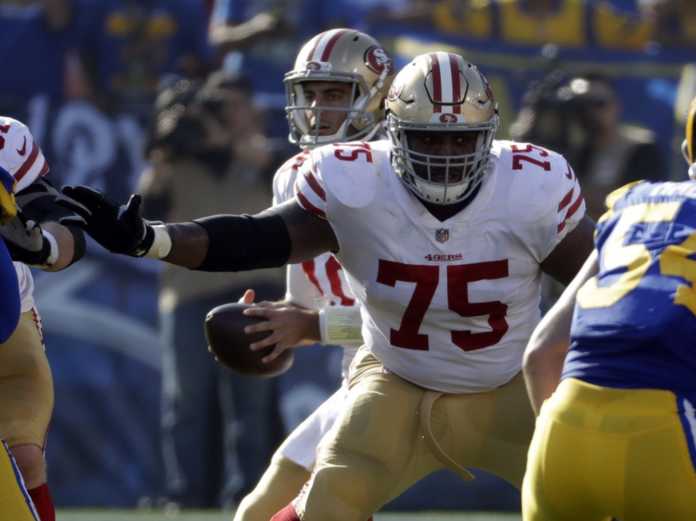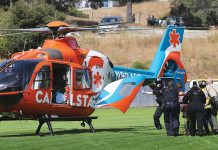There are several reasons why the San Francisco 49ers have been an NFL bottom feeder for the past three seasons. A pair of coaches that did very little to motivate the entire 53-man roster, a string of average drafts, and — before the arrival of Jimmy Garoppolo — quarterback talent that ranged between “oh, God, make it stop” and OK. But possibly the biggest reason San Francisco has struggled to be even mediocre since Jim Harbaugh’s departure, has been the play along the offensive line.
The Niners made it to three straight NFC Championships and a Super Bowl behind a huge athletic wall of bodies clearing the way for Frank Gore. I’m not here to reminisce about better days — but, man, weren’t Frank Gore jump cuts off a Mike Iupati pulling block great? I’m simply making the case that behind every Super Bowl caliber team, there is a great offensive line.
Here are the top five run blocking offensive lines in the NFL this season, according to Football Outsiders:
1. New England Patriots
2. New Orleans Saints
3. Los Angeles Rams
4. Dallas Cowboys
5. Green Bay Packers
It’s no mistake that the top two teams are the favorites to meet in this year’s Super Bowl and see Justin Timberlake get a redo at the halftime show — if Janet Jackson doesn’t at the very least make a cameo, we riot.
Sure, the game has changed. Teams throw the ball more than ever, and there are several reasons for this. But the teams that find a balance between the “new” NFL and the game that it used to be, tend to be the franchises holding up the Lombardi Trophy at the end of the season.
The Niners’ offensive line ranked 11th in run blocking this season, according to Football Outsiders. They were the worst run blocking unit in the NFL — that is not an embellishment — in 2016 and ‘15. The year they went to the Super Bowl? They were ranked first.
Yes, the Niners need to lockup Garoppolo. Yes, Jimmy GQ needs a No. 1 option. Yes, the defense needs a serviceable pass rusher. But fixing the interior of the offensive line should also be high on John Lynch’s offseason to-do list.
Center Daniel Kilgore and right guard Brandon Fusco are free agents. Neither played like all-pros this season. Kilgore flashed some good signs down the stretch, and Fusco had some OK moments that sometimes masked the bad. Kilgore won’t make a Pro Bowl, but he’s good enough to warrant another deal with the team at the right price.
Left guard Laken Tomlinson is under contract for another two years — he has a team option in 2019 — but his play was so-so this year, too. To make matters worse, Zane Beadles, who rode the pine most of the season, is somehow set to make $3 million next year. Only Pro Bowl left tackle Joe Staley (about $8 million) will make more money than him among the Niners’ returning offensive linemen.
The good news? The Niners have the most money of any team in the NFL to spend this offseason — $119,909,412 to be exact (“Bank Account” by 21 Savage starts playing).
Signing Andrew Norwell and plugging him in at left guard would be a massive upgrade, but would Lynch be willing to throw somewhere in the neighborhood of $9 million his way for the next three years with Beadles and Tomlinson already taking up more than $5 million combined in 2018?
The fact that the Carolina Panthers are strapped for cash this offseason gives the Niners a good chance to land him, and I hope they pull the trigger even with the hefty price tag. I say this because he’s the best offensive line talent available in free agency, and he gives the Niners their best chance to stabilize the interior of their line in the shortest amount of time.
Drafting a guard is not a bad idea, but it’s a much longer process and there’s some obvious risk involved. With his prototypical size (6-foot-5, 330 pounds), expert hand placement and solid footwork, Notre Dame’s Quentin Nelson is impressive and is being hyped as a future all-pro guard. But a lineman’s transition from college to the pros has gotten messier over the last 10 years.
Offensive line play is not only about having the biggest, strongest and smartest players. The five guys lining up shoulder to shoulder have to have a good feel for one another. They have to understand each other’s strengths and weaknesses, and they have to be able to make adjustments on the fly depending on those factors — and many more. The restrictions on practices written into the collective bargaining agreement in 2011 have undercut that meshing process. And so offensive lines are typically better a season or two after they’ve been brought together — another reason why bringing back Kilgore makes sense.
Take the Patriots’ offensive line. Last year, they were the ninth ranked run blocking unit. This season they were the best in the league. It’s no surprise that all five linemen have started side-by-side for the past two seasons. It takes time — and good coaching — to create a great offensive line.
Think of it like this: Migos didn’t come together and put out “Culture” in their first year. The talent was there, but Quevo, Takeoff and Offset were just getting a feel for what they could be when “Versace” released in 2013. It took a few years to perfect what they have now. They not only had to find out one another’s roles in the group, but they also had to be comfortable in them.
There are very few bands that put out their best work on the first try. It took the Beatles a few years to go from “Please Please Me” to “Rubber Soul.” But once a group figures it out, it’s fun to hear, watch, experience, etc.
Nelson has a chance to become a very good player, but he’ll not only have to get accustom to the rest of the offensive line, but the flow of an NFL system, too. Grabbing a veteran like Norwell gives the Niners a bit of a shortcut to success up front — and it’s a shortcut the team can afford this offseason.
Plus, there’s no guarantee that Nelson will become what all the scouts believe he will. The Niners invested a first round pick in Stanford guard Joshua Garnett in the 2016 draft, but have yet to reap the rewards. I keep reading about how Garnett is miraculously changing his body composition this offseason, but that still doesn’t change the fact that he was not very good as a rookie and is coming off a knee injury. The draft is risky. It always will be.
The Niners do have millions to spend this offseason, but they also have to think about the future. Garoppolo will make at least $25 million every year for the rest of his career in the Bay Area, and that already cuts the team’s cap space by nearly a quarter. Lynch still has to make a decision on whether he wants to pay Carlos Hyde and Eric Reid this summer. Right tackle Trent Brown, receiver Marquise Goodwin, kicker Robbie Gould and safeties Jaquiski Tartt and Jimmie Ward are all free agents in 2019. Additionally, cornerback Ahkello Witherspoon, defensive tackle DeForest Buckner, linebacker Reuben Foster and safety Adrian Colbert — four players that have become the heartbeat of a scrappy and young defense — will also demand big pay days in the next two or three years if they continue to star.
There’s no doubt that San Francisco is in a good position to dictate its future, but when building a sustainable championship team there’s very little room for error. Tough decisions have to be made, and sometimes fan favorites have to be shown the door. Lynch has made some great moves and picks so far, but this upcoming offseason is one that could set the team up to be a contender for years to come, or lead them down cap hell in the future.
Editor’s Note: In the weeks leading up to NFL free agency, Pajaronian Sports Editor Tony Nunez will dive into the Niners’ roster needs following their 6-10 season.












